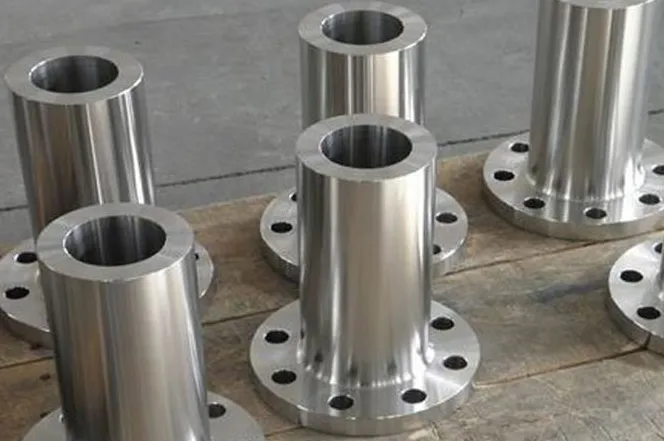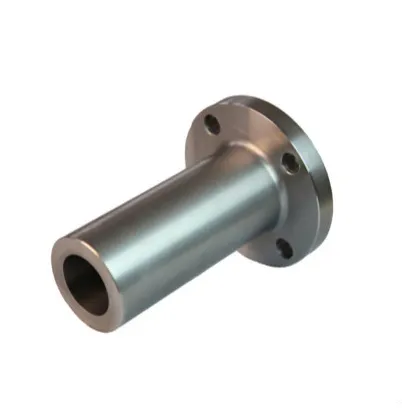General Introduction
Standard Compliance: ASME B16.5 is a crucial American standard that deals with pipe flanges and flanged fittings.
Function: It is a key component in piping systems, mainly used to connect pipes, valves, pumps, and other equipment. It provides a reliable connection and allows for easy installation, disassembly, and maintenance of the piping system.
Design and Structure
Weld Neck Design: The most distinctive feature is the long weld neck. This neck is longer than that of a regular weld neck flange and is designed to be welded to the pipe. The extended length of the neck provides several advantages, including better stress distribution and enhanced resistance to fatigue and thermal cycling.
Face Type: It typically has a raised face. The raised face helps to create a better sealing surface when mated with another flange or equipment. It provides a more effective seal, reducing the risk of leakage and ensuring the integrity of the piping system..
Dimensions and Specifications
Diameter: Available in a wide range of sizes, typically from 1/2 inch to 24 inches or even larger in some cases.
Materials
Common Materials: Carbon steel is a popular choice for long weld neck flanges due to its good strength, durability, and cost-effectiveness. Stainless steel, such as 304 and 316 grades, is often used in applications where corrosion resistance is required, such as in the chemical, food, and pharmaceutical industries. Alloy steels may be used for high-temperature or high-pressure applications that require enhanced mechanical properties.
Material Properties: The materials used must have suitable mechanical properties, including high tensile strength, good ductility, and resistance to cracking and deformation. They should also be able to withstand the operating conditions of the piping system, such as temperature, pressure, and chemical exposure.
Pressure-Temperature Ratings
Rated Pressure: ASME B16.5 defines specific pressure ratings for long weld neck flanges. These ratings range from low-pressure classes like 150 psi to high-pressure classes such as 2500 psi. The pressure rating of a flange depends on its material, size, and design.
Temperature Limits: The allowable temperature range for the flange also varies depending on the material. For example, carbon steel flanges are typically suitable for operating temperatures up to a certain limit, while stainless steel flanges can withstand higher temperatures. It's essential to select the appropriate flange with the correct pressure-temperature rating to ensure the safe and reliable operation of the piping system.
Applications
Oil and Gas Industry: Widely used in oil and gas production, refining, and transportation. They are used in pipelines that carry crude oil, natural gas, and various petroleum products. The long weld neck design is particularly suitable for high-pressure and high-temperature applications in this industry.
Chemical Industry: In chemical plants, these flanges are used in piping systems that transport corrosive and hazardous chemicals. The corrosion-resistant materials and reliable sealing of long weld neck flanges make them ideal for such applications.
Power Generation: Used in power plants, including fossil fuel-powered and nuclear power plants. They are part of the piping systems for steam, water, and other fluids in the power generation process.
Other Industries: Also find applications in industries such as pharmaceuticals, food and beverage, and pulp and paper. In these industries, they are used in piping systems that require high-quality connections and reliable sealing.
-
Cangzhou Yulong Steel Co., Ltd.
-
Phone:
+86 13303177267 -
Email:
admin@ylsteelfittings.com
- English
- Arabic
- Italian
- Spanish
- Portuguese
- German
- kazakh
- Persian
- Greek
- French
- Russian
- Polish
- Thai
- Indonesian
- Vietnamese
- Zulu
- Korean
- Uzbek
- Hindi
- Serbian
- Malay
- Ukrainian
- Gujarati
- Haitian Creole
- hausa
- hawaiian
- Hebrew
- Miao
- Hungarian
- Icelandic
- igbo
- irish
- Japanese
- Javanese
- Kannada
- Khmer
- Rwandese
- Afrikaans
- Albanian
- Amharic
- Armenian
- Azerbaijani
- Basque
- Belarusian
- Bengali
- Bosnian
- Bulgarian
- Catalan
- Cebuano
- China
- China (Taiwan)
- Corsican
- Croatian
- Czech
- Danish
- Esperanto
- Estonian
- Finnish
- Frisian
- Galician
- Georgian
- Kurdish
- Kyrgyz
- Lao
- Latin
- Latvian
- Lithuanian
- Luxembourgish
- Macedonian
- Malgashi
- Malayalam
- Maltese
- Maori
- Marathi
- Mongolian
- Myanmar
- Nepali
- Norwegian
- Norwegian
- Occitan
- Pashto
- Dutch
- Punjabi
- Romanian
- Samoan
- Scottish Gaelic
- Sesotho
- Shona
- Sindhi
- Sinhala
- Slovak
- Slovenian
- Somali
- Sundanese
- Swahili
- Swedish
- Tagalog
- Tajik
- Tamil
- Tatar
- Telugu
- Turkish
- Turkmen
- Urdu
- Uighur
- Welsh
- Bantu
- Yiddish
- Yoruba

Write your message here and send it to us
Related News
-
Jul . 23, 2025Space-Saving Connection Mastery: How 1/2 Pipe Nipple’s 50mm Short Design Solves Dense Piping Installation Challenges?In the labyrinth of industrial machinery, where pipes weave through 200mm-wide gaps and every millimeter counts, the battle against cramped spaces often stalls projects.
-
Jul . 23, 2025Shale Gas Extraction Impact Resistance: How ASME B16.47 Flange's Hub-Thickened Design Passes Seismic Testing?In the high-stakes realm of shale gas extraction, where seismic activity and operational vibrations threaten pipeline integrity, the ASME B16.47 flange emerges as a critical safeguard.















